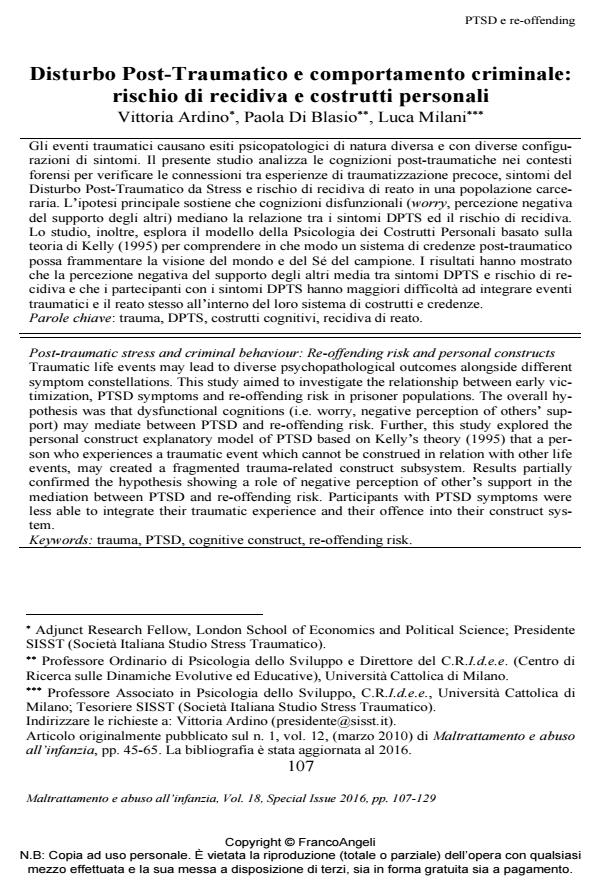Disturbo Post-Traumatico e comportamento criminale: rischio di recidiva e costrutti personali
Titolo Rivista MALTRATTAMENTO E ABUSO ALL’INFANZIA
Autori/Curatori Vittoria Ardino, Paola Di Blasio, Luca Milani
Anno di pubblicazione 2016 Fascicolo 2016/2 suppl.
Lingua Italiano Numero pagine 23 P. 107-129 Dimensione file 272 KB
DOI 10.3280/MAL2016-S02007
Il DOI è il codice a barre della proprietà intellettuale: per saperne di più
clicca qui
Qui sotto puoi vedere in anteprima la prima pagina di questo articolo.
Se questo articolo ti interessa, lo puoi acquistare (e scaricare in formato pdf) seguendo le facili indicazioni per acquistare il download credit. Acquista Download Credits per scaricare questo Articolo in formato PDF

FrancoAngeli è membro della Publishers International Linking Association, Inc (PILA)associazione indipendente e non profit per facilitare (attraverso i servizi tecnologici implementati da CrossRef.org) l’accesso degli studiosi ai contenuti digitali nelle pubblicazioni professionali e scientifiche
Gli eventi traumatici causano esiti psicopatologici di natura diversa e con diverse configurazioni di sintomi. Il presente studio analizza le cognizioni post-traumatiche nei contesti forensi per verificare le connessioni tra esperienze di traumatizzazione precoce, sintomi del Disturbo Post-Traumatico da Stress e rischio di recidiva di reato in una popolazione carceraria. L’ipotesi principale sostiene che cognizioni disfunzionali (worry, percezione negativa del supporto degli altri) mediano la relazione tra i sintomi DPTS ed il rischio di recidiva. Lo studio, inoltre, esplora il modello della Psicologia dei Costrutti Personali basato sulla teoria di Kelly (1995) per comprendere in che modo un sistema di credenze post-traumatico possa frammentare la visione del mondo e del Sé del campione. I risultati hanno mostrato che la percezione negativa del supporto degli altri media tra sintomi DPTS e rischio di recidiva e che i partecipanti con i sintomi DPTS hanno maggiori difficoltà ad integrare eventi traumatici e il reato stesso all’interno del loro sistema di costrutti e credenze.
Parole chiave:Trauma, DPTS, costrutti cognitivi, recidiva di reato.
- Fattori psicologici che procrastinano la richiesta d'aiuto nella violenza domestica: il ruolo delle dinamiche familiari Ugo Pace, Marco Cacioppo, Carla Zappulla, Giulio D’Urso, Vincenzo Caretti, in MALTRATTAMENTO E ABUSO ALL'INFANZIA 3/2018 pp.73
DOI: 10.3280/MAL2018-003005 - Vissuti traumatici nell'infanzia di minori autori di reato, carriera criminale e desistenza dal crimine Alfredo Verde, Gabriele Rocca, Giulia Gibelli, in MALTRATTAMENTO E ABUSO ALL'INFANZIA 2/2025 pp.71
DOI: 10.3280/MAL2025-002004 - Il bambino violato: aspetti moderni del maltrattamento che il pediatra deve conoscere Pietro Ferrara, Annamaria Sbordone, Ester Del Vescovo, Francesca Ianniello, Antonio Ruggiero, in MALTRATTAMENTO E ABUSO ALL'INFANZIA 1/2018 pp.103
DOI: 10.3280/MAL2018-001008 - Il minore reo sessuale tra pena e trattamento: una ricerca nell'area milanese Paolo Giulini, Federica de Gregorio, in MALTRATTAMENTO E ABUSO ALL'INFANZIA 3/2017 pp.53
DOI: 10.3280/MAL2016-003004 - L'assessment psicodiagnostico di bambini vittime di Adverse Childood Experience (ACE): discussione di un caso clinico Daniela D’Elia, Annamaria Scapicchio, Marta Sisto, in MALTRATTAMENTO E ABUSO ALL'INFANZIA 3/2019 pp.75
DOI: 10.3280/MAL2019-003006
Vittoria Ardino, Paola Di Blasio, Luca Milani, Disturbo Post-Traumatico e comportamento criminale: rischio di recidiva e costrutti personali in "MALTRATTAMENTO E ABUSO ALL’INFANZIA" 2 suppl./2016, pp 107-129, DOI: 10.3280/MAL2016-S02007